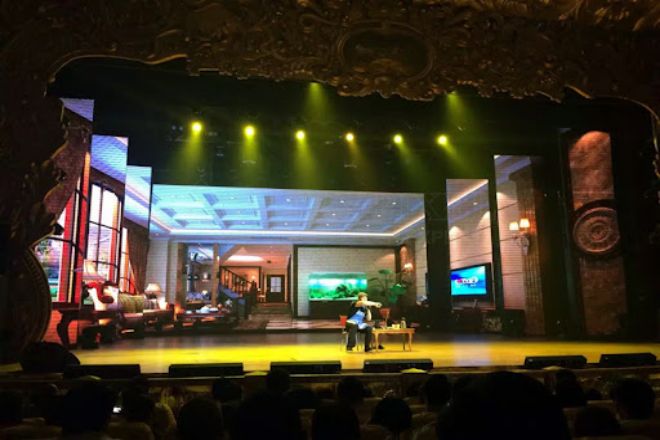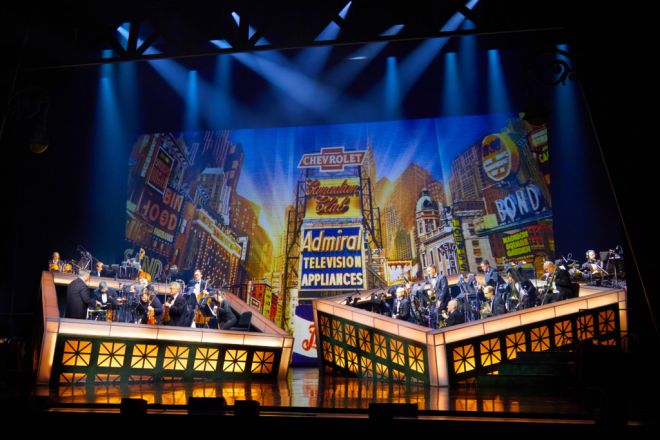序章

Stepping into the theater, every performance is a touch to the soul and a feast for the eyes. But now, when the bright light of the LED display illuminates the ステージ, all this is being redefined.
From traditional static scenery to today’s dynamic transformation, from a single performance presentation to multi-sensory immersive interaction, LEDディスプレイ have injected new vitality and creativity into theater performances with their unparalleled flexibility and expressiveness.
This article will take you to an in-depth exploration of how LED displays can unlock new horizons in theaters, revealing how this technology can bring unprecedented shock and interactive experience to theater performances.
1. Innovative application background of LED display screen in theaters
1). Technological innovation driving force
In recent years, LED display technology has made significant progress and has become a key factor in promoting the visual presentation revolution in theaters.
Continuous breakthroughs in high-definition display technology enable LED screens to present delicate images with extremely high color reproduction, bringing a more realistic and vivid visual experience to the audience.
At the same time, the high-輝度 feature ensures that the screen content is still clearly visible even in a strong light environment, meeting the needs of theaters under complex lighting conditions.
The application of wide color gamut technology further broadens the range of color expression, making the picture more vivid and full and enhancing the appeal of the performance.
In addition, the flexible splicing capabilities of LED displays allow the screens to be customized according to the actual space and needs of the theater to achieve seamless splicing, providing more possibilities for stage design.
2) 市場需要の変化
With the improvement of audiences’ aesthetic level and the diversification of entertainment methods, their expectations for theater performances are no longer limited to traditional performance forms.
Audiences crave a more immersive viewing experience, hoping to resonate emotionally with the performance and even participate in the performance process.
This growing demand for immersive and interactive performance experiences has prompted theaters to continuously explore new technological means to meet the needs of audiences. LED display screen, with its unique advantages, is an ideal choice to achieve this goal.
Through dynamically changing images and real-time interactive functions, the LED display screen creates an all-round, multi-sensory viewing environment for the audience, allowing them to feel as if they are in the performance and share their joys and sorrows with the characters.
3). Theater transformation and upgrading needs
In the context of the digital and networked era, traditional theaters are facing unprecedented challenges and opportunities.
On the one hand, emerging digital entertainment methods continue to impact the market share of traditional theaters; on the other hand, advances in technology have also brought unprecedented development opportunities to theaters.
In order to cope with these challenges and seize opportunities, theaters need to continuously transform and upgrade to enhance their competitiveness and attractiveness.
As a model of the combination of modern technology and traditional art, LED display screens have become an important tool for theater innovation and transformation. By introducing LED display technology, theaters can break the limitations of traditional stages and achieve more diversified and personalized performance forms.
At the same time, they can also use digital means to improve the audience’s viewing experience and service quality and enhance the theater’s brand influence. And market competitiveness.
2. Specific application scenarios of LED display screens in theaters

1). Stage background and scenery
The application of LED display screens on theater stages greatly enriches the expressiveness of backgrounds and scenery. As a dynamic stage background, the LED display screen can display high-definition and gorgeous images in real-time, enabling instant scene transitions without the need for complex physical scenery changes.
This not only saves time and labor costs but also enhances the storytelling and visual impact of the performance.
In addition, through the combination of virtual reality (VR) and augmented reality (AR) technologies, LED displays can create scenery effects that transcend reality, making the audience feel like they are in a new world and enjoy an unprecedented visual feast.
2). Audience interactive experience
In order to enhance the audience’s sense of participation and immersion, theaters began to install LED displays around or above the auditorium.
These displays are not only used to display performance information in real-time, such as program lists, actor introductions, etc., but also for interactive audience voting, special effects feedback, and other activities.
Audiences can participate in the interaction through mobile phones or other devices, and their feedback will be displayed on the LED screen instantly, forming a strong interactive effect.
Furthermore, the LED display can also realize the interaction between the audience and the actors across time and space, such as allowing the actors to have direct conversations with the audience through video connections or adjusting the performance content according to the audience’s reaction, which greatly increases the fun and interaction of the performance.
3). Multifunctional hall and rest area
The multifunctional halls and rest areas of theaters are also important application areas for LED displays.
During non-performance hours, the LED display screen can play trailers, promotional videos, art 展示会, and other content to attract the audience to stop and watch, improving the theater’s non-performance time utilization and attraction.
At the same time, the LED display can also be used as a tool for theater navigation and information services, providing audiences with convenient route guidance, seat inquiries, performance schedules, and other information services to enhance the overall audience experience.
4). Special Effects and Light and Shadow Art
The perfect combination of LED display screen, lighting, sound, and other systems creates unique light and shadow effects for theater performances.
Through programming control, the LED display screen can show various changes in colors, shapes, and patterns, echoing with the lights and sounds, creating a variety of emotional atmospheres such as mystery, romance, excitement, and so on.
In addition, LED displays also have unique advantages in expressing abstract concepts and creating an emotional atmosphere.
It can present the theme and emotional core of the performance in an intuitive and creative way, expand the artistic boundaries of theater performance, and give the audience a double shock both visually and spiritually.
3. What substantial benefits will the use of LED displays in theaters bring?
The use of LED displays in theaters will bring many substantial benefits, which are not only reflected in the audience’s viewing experience but also cover the theater’s operational efficiency, artistic expression, and economic benefits. Here are the specific benefits:
1). Improve the viewing experience:
Enhance visual impact: The LED display can present high-definition, bright images, and videos, making the stage background and scenery more vivid and lifelike, enhancing the audience’s visual enjoyment.
Enhanced immersion: Through dynamically changing images and light and shadow effects, LED displays can create a more realistic scene atmosphere, making the audience feel as if they are in the plot and improving immersion.
Real-time interaction: Installing LED displays around or above the auditorium can realize real-time interaction between the audience and actors, such as voting, comment feedback, etc., making the performance more interesting and interactive.
2). Improve artistic expression:
Quick scene change: The LED display can realize instant scene change without the need for complex physical scenery changes, improving the flexibility and coherence of the performance.
Creative expression: LED display screen provides a broader space for artistic creation. Artists can use its unique visual effects to express abstract concepts, emotional atmosphere, etc., and expand the artistic boundaries of the theater.
Light and shadow art: Combined with lighting, sound, and other systems, LED displays can create unique light and shadow effects, adding mystery and artistry to the performance.
3). Improve operational efficiency:
Information display: LED display screen can be used to play performance information, program list, actor introduction, and other content to facilitate the audience’s understanding of the performance details.
Advertising revenue: During non-performance hours, the LED display can be used to play advertisements, promotional videos and other content, bringing additional advertising revenue to the theater.
Navigation service: Provide information services such as theater navigation and seat inquiry through LED displays to improve the convenience of the audience.
4). Economic benefits:
Attract audiences: The introduction of LED displays can enhance the technological and modern feel of the theater and attract more audiences to watch performances.
Increase ticket prices: Due to the improved visual enjoyment and immersion brought by LED displays, theaters have reason to increase ticket prices, thus increasing revenue.
Long-term return on investment: Although the initial investment of LED displays is relatively large, its long 人生, low maintenance costs, and high efficiency make it have a high return on investment.
4. Theater LED display FAQs

1). The theater environment is complex, and the space is limited. How does the LED display dissipate heat?
- 解決:
Use efficient heat dissipation technology, such as heat pipe heat dissipation, liquid cooling heat dissipation, etc., to improve heat dissipation efficiency.
At the same time, the structural design of the display screen is optimized to increase the heat dissipation area and ensure that heat can be discharged in time.
In addition, the use time and intensity of the display should be rationally arranged to avoid long-term overload operation.
2). LED displays have high 消費電力 and operating costs
- 解決:
Use energy-saving LED displays to reduce energy consumption. At the same time, strengthen equipment management and maintenance, extend the service life of equipment, and reduce the frequency of replacement.
In addition, theater revenue can be increased by increasing performance ticket prices and advertising revenue to ease operating cost pressures.
3). Challenges in coordination between LED display screen and lighting and sound
- 解決:
Strengthen technical training and exchanges to improve the professional capabilities of technical personnel. At the same time, we establish close cooperative relationships with equipment suppliers to jointly solve technical problems.
In addition, standardized technical specifications and processes are adopted to ensure equipment compatibility and stability.
結論
With the continuous advancement of technology and the increasingly diverse needs of audiences, the application prospects of LED displays in the theater field will be broader.
It is not only a powerful tool to improve the visual effects of performances and enhance audience immersion but also an important force in promoting the innovation and development of the theater industry.
Through continuous exploration and practice, we believe that LED display screens will shine brighter on the theater stage and bring more diverse, high-quality cultural and artistic enjoyment to the audience.
最後に、LEDディスプレイについてさらに詳しく知りたい場合は、 ご連絡ください。
